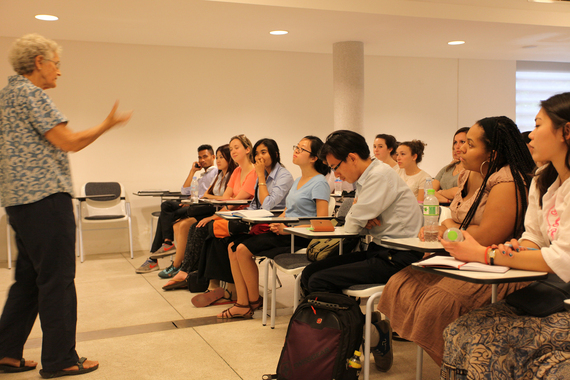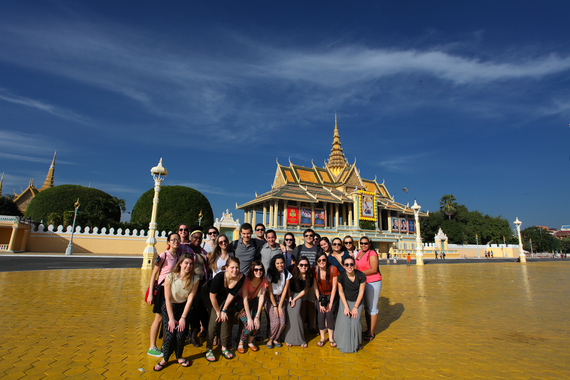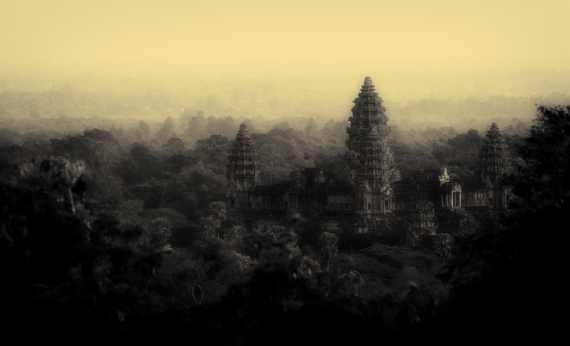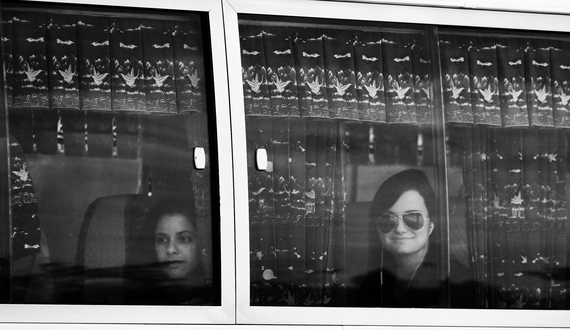Co-authored by David J. Fine and Whitney Szmodis
WE'RE TOLD the time is right for a holiday in Cambodia. The country is open to the West, but not too far open: the beaches remain unspoiled and warm, the natives Buddhist and friendly, the temples exotic and serene. There is, indeed, so much for the West to learn about the country deemed "The Kingdom of Wonder": it's no surprise tourists increasingly flock to Cambodia. Even Orange Is the New Black inmates, albeit the privileged ones, pine to return to Cambodia's beaches after their release. And yet, no matter how many reasons exist for Westerners to travel there -- art, nature, food -- the nation's past asks difficult questions of the global citizen's present. The Kingdom of Wonder reveals itself to visitors in subtle yet magical ways, if you prepare yourself to take heed. Beyond the beaches and the delicious cuisine, deep in the shadows of Angkor Wat, hidden behind smiling faces, are the untold stories of a land full of awe. Brace yourself, my dear.
For Lehigh University's Global Citizenship (GC) Program's 2015 annual intersession trip, we took twenty-three students to Cambodia. We chose Cambodia for numerous reasons: for the increasing exposure Westerners have to the country as a tourist destination, for its impressive history of the Khmer Empire and the construction of its temples, as well as for the more recent history of pain and torture during the Khmer Rouge genocide from 1975-1979. The longstanding partnership between Lehigh University and Caring for Cambodia (CFC) -- an NGO dedicated to building a brighter future for Cambodian children through providing support to twenty-one, K-12 government schools -- gave us the final piece of the puzzle for the complete GC experience.
Within a two-week span, the students would tour schools and museums, attend a Khmer Rouge tribunal session, meet with many NGOs from mental-health-related to land mine issues, and engage with the culture in as deep and meaningful a way as the short but packed itinerary permitted. Of course, students would also swim in the Gulf of Thailand, meditate with monks, and, at the trip's conclusion, watch the sun set over Angkor Wat. They would experience Cambodia.
Still, in the context of a program like GC, questions arose quite naturally like towers on the Mekong. How does one tour responsibly? To what extent should Cambodia's past inform plans for travel in the present, which is to say: How ought one to balance the sanguinary with the sanguine? How does one witness, fairly, a horrific genocide in which an estimated 1.7 million people died? How, as higher education professionals, do we expose our students to the choices implicit in our global programming and make those decisions an object for critical reflection and dialogue? A trip to Cambodia expressly devoted to the cultivation of global citizenship must distinguish itself as such; it must diverge, sharply, from both traditional short-term study-abroad programming and international service missions. Right Guard will not help you here, indeed.
After all, there are so many distractions -- shopping, dining, exploring - -and it's difficult for educators to compete with all Cambodia has to offer travelers. And so, we decidedly planned our half-day visit to Caring for Cambodia with an eye toward reflection and analysis. A week and a half into the intersession trip, we divided the students into three different teams. Each group would visit a different CFC school with the three of us serving as facilitators. Neither did we inform the students in advance of the split nor did we explain the work that the other teams would be doing. We woke up in the morning. We divided in three. We entered tuk-tuks. We left.
The first group -- comprising various student leaders on Lehigh's campus -- engaged in traditional volunteer work. They painted stools and assembled hygiene packets. They did not work with CFC students directly; in this sense, the unglamorous labor was completely hands-off. The second team -- composed largely of English Language Learners and an English major--observed an English class at a CFC school. They offered feedback to the instructor, drawing from their own experience learning English in the States and abroad. Here, they collaborated with CFC faculty, drawing connections to their own backgrounds and abilities. A final group of global citizens interacted directly with CFC high school students. The CFC pupils taught the GC students some traditional Khmer gardening methods and then invited them to assist in planting a small garden patch. Nothing major, nothing life-altering: this group ended their visit with a game of catch.

Lehigh GC students working in group 1, painting stools. This was Tamara's (center) first travel experience abroad. Photo: Sothy Eng
At our nightly reflection, students shared their reactions to CFC and quickly realized that they did unalike things. Some volunteered. Others observed. A few planted. We had invited CFC's Deputy Country Director to attend the session, and she asked questions of interest to CFC and its programming for international volunteers along the way.
The conversation asked students to consider which visit worked best, in the end, and to articulate the reasoning behind their choices. There were obvious advantages and disadvantages to all three models. As such, the reflection did not result in a clear plan of action, but it did place the issues of service, privilege, and responsibility at the forefront of that evening's reflection. Indeed, the connections amongst Cambodia's past and present crystallized in and through an afternoon's work with CFC. Some of the hidden stories began to emerge there more vividly, as it became increasingly clear that, like any good reader, one must consider the point of view from which the story is told.
The CFC schools would look very different without NGO support, and, as students passed other schools on the trip, they became even more aware of the essential role CFC plays in providing a quality education to so many students. As we traveled, we passed boarded-up schools with faded NGO logos on the signs. The students saw firsthand the importance of sustainability, seeing how vital it is to follow through with the promise to help rebuild a country. While we passed too many NGO "graveyards" -- closed schools and community centers from NGOs leaving before the Cambodians had a chance to build up the resources necessary to continue the programs -- the students further reflected on their experiences at CFC schools and their implications for Cambodia's future.
Traveling with a group of twenty-three undergraduates, who have only been to school for a year or two, presents a series of transformative possibilities. This potential lies at the heart of global citizenship, and Lehigh University's GC Program has prepared students since 2004 for engaged living in a culturally diverse and rapidly changing world. Emphasizing critical analysis and value reflection, the program structures educational experiences through which students learn to negotiate boundaries and develop their own sense of personal, social and corporate responsibility to a global community. In addition to locally driven civic engagement and globally infused course work, all GC students participate in an intersession trip abroad. This two-week venture to a developing or non-Western nation seeks to increase students' awareness of transnational issues and to give them practice in negotiating cultural difference.
As we developed our intersession-trip programming, we knew, implicitly, that we wanted to follow Hannah Arendt in her interpretation of Immanuel Kant's world citizen. Kant's cosmopolitanism does not conceive of a global governing structure to which we all belong as citizens; rather, Arendt explains how Kant's global citizen adopts the position of an onlooker, one who sees, analyzes, and judges. According to Kant, "by comparing our judgment with the possible rather than the actual judgments of others, and by putting ourselves in the place of any other man," the world citizen engages his imagination and reflection in order to make informed judgments on world affairs. The global citizen imagines herself "in the place of any other man" and considers conceivable responses of others as she forms and hazards her own conclusions.
Our visit to CFC schools sought to model how the world citizen might adopt the position of the spectator, who imagines the experience of others and reflects upon it. This mode of global citizenship occurs apart from physical doing -- often it, indeed, hesitates to act -- and this point is one Kant makes explicit. The global citizen looks at the world's complexity with humility and then makes judgments, knowing efficacious, sustainable action depends on much more than the implementation of York Harding's teachings.
Of course, to train the mind "to go visiting," in Hannah Arendt's sense of the cosmopolitan, is different from a trip to go visiting in person. The latter demands that students practice, physically, the skills that will be necessary for the former imaginative labor. And yet, both take work. Globalization necessitates that educators train a generation of globally aware citizens, but this awareness does not just happen. It must be modeled. It must be practiced. It must be exercised with, rather than against, difference, until it becomes habitual.

Local as well as GC students listened to Dr. Luise Ahrens's lecture on the Cambodian history and education at the Royal University of Phnom Penh. Photo: Sothy Eng
Traveling with twenty-three global citizens to Cambodia captured, in this sense, the root meaning of travel -- from the Old French, travaillier, "to put to torture, to torment" and then "to work"--and perhaps suggests that, in addition to relaxing and shopping, visitors to Cambodia should engage the tormenting work of exploring why they chose Cambodia, and what their presence in the country means to their personal growth as well as the growth of a nation. It may be the ideal time to travel to Cambodia on holiday, and you will be greeted with a warmth and hospitality unlike anywhere else in the world. Just remember: the Kingdom of Wonder has more to teach you than what you see on the surface. Explore. Respect. Question. And always look deeper, as awe and inspiration await hidden below.
--
David J. Fine serves as the assistant director of Lehigh University's Global Citizenship Program and is a Ph.D. candidate in English literature. With the Global Citizenship Program, he has traveled to China, India, and Cambodia and has taught a wide variety of experiential, community-engaged courses. He can be reached at djf207@lehigh.edu
Whitney Szmodis is a Ph.D. candidate in Teaching, Learning, and Technology at Lehigh University, Bethlehem, Pennsylvania. Her area of research focuses on the gender disparity in STEM education in Cambodia and the role that socio-cultural factors play in girls' aspirations to their future careers. She can be reached at wes307@lehigh.edu.
Sothy Eng is Professor of Practice in Comparative and International Education at Lehigh University.



